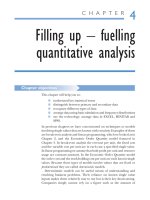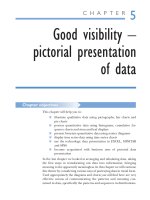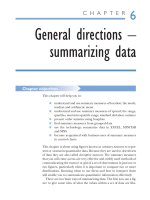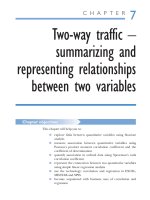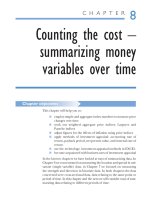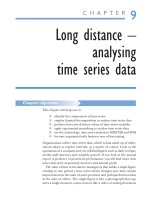Research methods for business 5th ch1
Bạn đang xem bản rút gọn của tài liệu. Xem và tải ngay bản đầy đủ của tài liệu tại đây (252.78 KB, 20 trang )
Slide 1.1
Chapter 1
The nature of business and management
research and the structure of this book
Saunders, Lewis and Thornhill, Research Methods for Business Students, 5th Edition, © Mark Saunders, Philip Lewis and Adrian Thornhill 2009
Slide 1.2
Saunders, Lewis and Thornhill, Research Methods for Business Students, 5th Edition, © Mark Saunders, Philip Lewis and Adrian Thornhill 2009
Slide 1.3
Saunders, Lewis and Thornhill, Research Methods for Business Students, 5th Edition, © Mark Saunders, Philip Lewis and Adrian Thornhill 2009
Slide 1.4
Introduction to the research process
Things to consider
• Realities and pitfalls of research
• Approaches, strategies and methods
• Techniques and procedures for data collection
and analysis
• Appropriate use of information technology
Saunders, Lewis and Thornhill, Research Methods for Business Students, 5th Edition, © Mark Saunders, Philip Lewis and Adrian Thornhill 2009
Slide 1.5
Terminology
Methods The techniques and procedures used to obtain
data
Methodology The theory of how research should be
undertaken
Saunders, Lewis and Thornhill, Research Methods for Business Students, 5th Edition, © Mark Saunders, Philip Lewis and Adrian Thornhill 2009
Slide 1.6
The nature of research
Definition:
‘Something that people undertake in order to find things
out in a systematic way, thereby increasing their
knowledge’
Saunders et al. (2009)
Characteristics:
• Data are collected systematically
• Data are interpreted systematically
• There is a clear purpose to find things out
Saunders, Lewis and Thornhill, Research Methods for Business Students, 5th Edition, © Mark Saunders, Philip Lewis and Adrian Thornhill 2009
Slide 1.7
Saunders, Lewis and Thornhill, Research Methods for Business Students, 5th Edition, © Mark Saunders, Philip Lewis and Adrian Thornhill 2009
Slide 1.8
Saunders, Lewis and Thornhill, Research Methods for Business Students, 5th Edition, © Mark Saunders, Philip Lewis and Adrian Thornhill 2009
Slide 1.9
Features of business and management
research (1)
• Managers draw on knowledge from other disciplines
• Managers are more likely to allow access if they see
commercial or personal advantage
• Managers now tend to be as educated as the
researchers
• Managers require research to have some practical
consequence
Easterby-Smith et al. (2008)
Saunders, Lewis and Thornhill, Research Methods for Business Students, 5th Edition, © Mark Saunders, Philip Lewis and Adrian Thornhill 2009
Slide 1.10
Features of business and management
research (1)
Key debates
• Knowledge production –
(Modes 1, 2 and 3 knowledge)
• The ‘relevance gap’
• ‘Evidence based’ management
• Basic and applied research
Saunders, Lewis and Thornhill, Research Methods for Business Students, 5th Edition, © Mark Saunders, Philip Lewis and Adrian Thornhill 2009
Slide 1.11
Features of business and management
research (2)
Basic and applied research
Sources:
authors’ experience; Easterby-Smith et al. (2008); Hedrick et al. (1993)
Figure 1.1 Basic and applied research
Saunders, Lewis and Thornhill, Research Methods for Business Students, 5th Edition, © Mark Saunders, Philip Lewis and Adrian Thornhill 2009
Slide 1.12
The research process (1)
Stages of the research process
• Formulating and clarifying a topic
• Reviewing the literature
• Designing the research
• Collecting data
• Analysing data
• Writing up
Based on Figure 1.2: Saunders et al. (2009)
Saunders, Lewis and Thornhill, Research Methods for Business Students, 5th Edition, © Mark Saunders, Philip Lewis and Adrian Thornhill 2009
Slide 1.13
The research process (2)
Factors to consider
• The impact of your personal feelings and beliefs
• Access to data
• Time and other resources
• Validity and reliability of the data
• Ethical issues
Saunders, Lewis and Thornhill, Research Methods for Business Students, 5th Edition, © Mark Saunders, Philip Lewis and Adrian Thornhill 2009
Slide 1.14
Purpose of the book
To help you undertake research by being
• Clear about what you are doing
• Why you are doing it
• The associated implications of what you are
about
to do
Saunders, Lewis and Thornhill, Research Methods for Business Students, 5th Edition, © Mark Saunders, Philip Lewis and Adrian Thornhill 2009
Slide 1.15
Overview of the Chapters (1)
• Tutorials for data analysis software
• Smarter Online Searching Guide
• Terminology that is defined and explained
• Examples of research projects
• Checklists for focused guidance
Saunders, Lewis and Thornhill, Research Methods for Business Students, 5th Edition, © Mark Saunders, Philip Lewis and Adrian Thornhill 2009
Slide 1.16
Overview of the Chapters (2)
Each Chapter contains:
• A summary of key points
• Self- check questions – and answers
• Review and discussion questions
• References and further reading
• A case study that highlights real research issues
Saunders, Lewis and Thornhill, Research Methods for Business Students, 5th Edition, © Mark Saunders, Philip Lewis and Adrian Thornhill 2009
Slide 1.17
Final Sections
• Bibliography
• Appendices
• Glossary
• Index
Saunders, Lewis and Thornhill, Research Methods for Business Students, 5th Edition, © Mark Saunders, Philip Lewis and Adrian Thornhill 2009
Slide 1.18
Summary: Chapter 1
Business and management research
• Is transdisciplinary
• Engages with both theory and practice
• Involves undertaking systematic research
• Should be undertaken with rigour
Saunders, Lewis and Thornhill, Research Methods for Business Students, 5th Edition, © Mark Saunders, Philip Lewis and Adrian Thornhill 2009
Slide 1.19
Summary: Chapter 1
The book acts as a guide to the research
process
by providing:
•
•
•
•
•
a series of research examples
checklists to help you acquire relevant knowledge
review and discussion questions
self-check questions - and answers
guidance as you generate material for your project
report
Saunders, Lewis and Thornhill, Research Methods for Business Students, 5th Edition, © Mark Saunders, Philip Lewis and Adrian Thornhill 2009
Slide 1.20
And finally……..
“there is no one best way for undertaking all
research”
Saunders et al. (2009)
Saunders, Lewis and Thornhill, Research Methods for Business Students, 5th Edition, © Mark Saunders, Philip Lewis and Adrian Thornhill 2009



